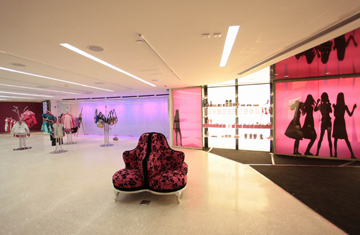
In 1956, Ruth Handler, an American businesswoman, was vacationing in Switzerland when she came across Bild Lilli, a doll that, unlike popular baby dolls at the time, had long, shapely legs and wore heavy makeup. Lilli, in fact, was based on a prostitute in a postwar German cartoon, but Handler was inspired. She bought three Lilli dolls, returned to California and in 1959 created the world's first Barbie doll.
Since then, Barbie's parent company Mattel has sold more than 1 billion copies of its hit toy by cultivating its wholesome image, making it as popular with American kids as it is safe for parents. But the toy industry has been changing. Girls are trading in traditional favorites for video games at younger ages while tweens flock to hipper dolls like Bratz, which launched in 2001 and quickly chewed into Barbie's market share. Mattel last year won a copyright-infringement case against Bratz owner MGA Entertainment, but that didn't change the fact that, over the past five years, Mattel's domestic sales of Barbie-related products have fallen by an average of 12% annually, according to estimates from investment-banking firm Needham & Co. At age 50, Barbie is clearly in need of a midlife makeover. Says M.G. Lord, author of Forever Barbie: The Unauthorized Biography of a Real Doll: "What kids want is a toy that shocks, and that toy is no longer Barbie."
Mattel isn't about to give up on one of the industry's most enduring success stories. But it is breaking out the marketing Botox. To revitalize the line, the world's largest toy company is not only adding some edge to Barbie's nonthreatening image, it is pitching Barbie-branded merchandise to a wider customer base — adults — and ramping up its overseas sales efforts, starting with the potentially vast China market, by opening dedicated Barbie concept stores (think Nike Store, but exceedingly pink). (See pictures of China's wild side.)
To get a sense of just how far Mattel is deviating from script requires a trip to the retail district in downtown Shanghai. There, on March 6, the company plans to open a 38,000-sq.-ft. (3,500 sq m) House of Barbie — the first of its kind in the world. This is nothing like the Main Street toy shop of yesterday. To enter the eight-story showpiece space, customers pass through a pink neon-lit tube, where the prerecorded sound of giggling girls grows progressively — some might say demonically — louder. After registering for a Barbie passport, visitors can get their hair and nails done at a spa and shop for makeup, accessories and even couture. Vera Wang is on board; she designed a $15,000 human-sized Barbie wedding dress to be sold exclusively at the Shanghai store. In a sleek design center, girls can use computers to sketch out their own Barbie fashions, and on another floor they can model them by walking a runway in Barbie clothing. At night, one of the store's two restaurants becomes a hip bar, complete with karaoke, a DJ and pink martinis. Says Hayes Zhou, food-and-beverage manager at Barbie Shanghai: "Barbies want to talk to Kens. You have to have a place for that."
With adult clothing, pricey collector's dolls and a pickup bar, the store sends a clear signal that Mattel intends to seduce an older demographic. This isn't as crazy as it may seem. In Asia, the Barbie brand is not deeply entrenched, so grown-ups are less likely to automatically dismiss it as kids' stuff. Besides, Asians don't necessarily put away childish things as they age. Collecting toys such as Hello Kitty merchandise well into adulthood is common. "Asian culture loves cute," says Richard Dickson, general manager of the Barbie brand. "They're much more comfortable with character art as part of fashion."
China was a logical place to launch a dedicated Barbie concept store for other reasons. Mattel imports 65% of its products from Chinese factories — a fact that became embarrassingly obvious in 2007, when the company had to recall nearly 20 million Chinese-made toys. Mattel later admitted that most of the defects, which included toxic lead paint and magnets that became lethal if ingested, were a result of design flaws, not manufacturing mistakes, but China's reputation had already taken a beating. The Shanghai store helps to repair the company's image in China.
It might seem risky to open a new, untested store at a time when U.S. toy retailers are suffering (KB Toys, the second largest U.S. toy chain behind Toys "R" Us, filed for bankruptcy in December). But Mattel is opportunistically positioning itself to thrive, not merely survive, in a tough environment. Today, two-thirds of Barbie sales come from 150 foreign markets; international sales increased 12% in 2007, even as U.S. sales sagged by 15%. "What we're doing in Shanghai is an indication for the future of the Barbie brand," Dickson says. Mattel is already planning similar stores in Brazil and Mexico.
One change Mattel is not making is in the doll itself. The company has produced ethnic dolls in the past, including a few it might like to forget, like the 1981 Oriental Barbie or the 1967 Colored Francie. But other than the fact that there is a brunette version, very little about the new Shanghai Barbie doll is different. Same long legs, same wasp waist. Barbie may be entering her golden years, but Mattel is betting there's life in the old gal yet.
